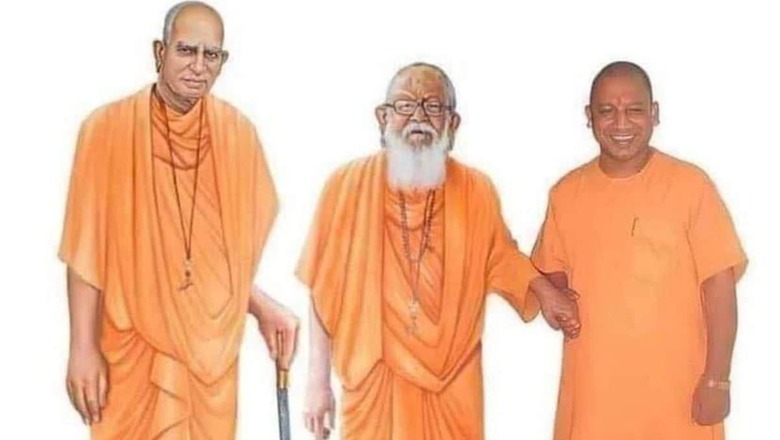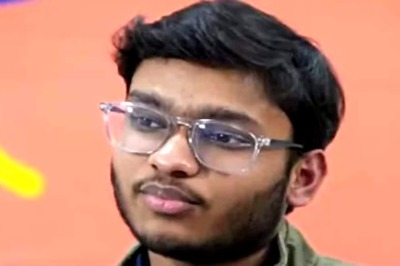
views
Gorakshpeeth has been associated with Ayodhya and Ram temple for three generations, and is about 100 years old. During this period, the Peethadhishwars have played a central role in every movement regarding the Ram Temple.
The current chairperson of Gorakshpeeth based in Gorakhpur is Uttar Pradesh Chief Minister Yogi Adityanath. His grandfather Guru Brahmleen Mahant Digvijay Nath and revered Gurudev Brahmaleen Mahant Avaidyanath had dreamed of a grand Ram temple in Ayodhya. The dream they had fought for is about to come true with the Pran Pratishtha of Ram Lalla on January 22.
Brahmleen Mahant Digvijay Nath gave organised form to the temple movement.
Actually, the sporadic struggle regarding Ram Lalla movement to re-establish the temple situated at Shri Ram Janmabhoomi had started after its demolition. The period of slavery from the Mughal to the British period and about 500 years of Independent India is a proof of this. There is documentary evidence of all the struggles and those who sacrificed themselves for it.
But for the first time after Independence, the credit for giving it a strategically organised form and a broad base goes to Guru Brahmin Goraksha, grandfather of CM Yogi Adityanath.
Peethadhishwar Goes to Mahant Digvijay Nath
He had started efforts in this regard after becoming Goraksh Peethadhishwar in 1935. In this sequence, along with uniting the sages and saints of different monasteries of Ayodhya, he also united the Hindus with equal feelings and respect beyond caste differences. Nine days before the appearance of the idol of Lord Shri Ram Lalla on December 22-23, 1949, the organisation of recitation of Akhand Ramayana had started under the leadership of Mahant Digvijay Nath. Mahant himself was present there at the appearance of Shri Ram Lalla. After the revelation of the idol of Lord Ram, the matter reached the court. Due to this, even though the disputed site was locked, for the first time, the priests were also allowed to perform daily puja there.
Mahant Digvijay Nath, who gave a new direction to the temple movement after the appearance of Shri Ram Lalla, continued to make continuous efforts for the salvation of Lord Ram’s birthplace till he took Maha Samadhi in 1969. These were the days after Independence. Congress storm was blowing. There was a competition to declare itself secular.
At that time, talking about Hindus and Hindutva meant being non-national. In this competition, many people were denying the existence of Lord Ram, who was worshiped by crores of people. Even in such adverse circumstances, with complete fearlessness, Digvijay Nath became the vocal voice of Hindus, Hindutva and Ram Mandir, from the House to Parliament and streets.
Mahant Avaidyanath was the universally accepted leader of the Ram Mandir movement.
The temple movement to which Mahant Digvijay Nath gave a solid foundation and broad base, after his death, attained new heights under the leadership of his disciple and successor Mahant Avaidyanath.
In the 1980s, the seed sown by Brahmaleen Mahant Digvijay Nath regarding Shri Ram Janmabhoomi had germinated. The biggest obstacle in expanding it was the difference of opinion among the saints of different sects and sects. Only the saint of the community could unite all these in a way that was acceptable to all. All this was accepted in favour of Gorakshpeethadhishwar Mahant Avaidyanath. The result of this consensus was that on July 21, 1984, when Shri Ram Janmabhoomi Mukti Yagna Committee was formed at Valmiki Bhawan in Ayodhya, Mahant Avaidyanath, was unanimously elected its president, and under his leadership such a mass movement emerged in the country which transformed the country’s social and political equations.
Shri Ram Janmabhoomi Movement Started
It was the largest and most effective movement after Independence. After the formation of Shri Ram Janmabhoomi Mukti Yagna Committee, a religious procession was taken out from the Saryu banks of Ayodhya on October 7, 1984, which reached Lucknow on October 14. A historic conference was held in Begum Hazrat Mahal Park in which lakhs of people participated. The then government was shaken by this conference held under the chairmanship of Mahant Avaidyanath. A delegation led by Mahant met Chief Minister Narayan Dutt Tiwari and submitted the demand letter.
On the call of religious leaders, a huge Hindu conference was organised at the Boat Club of Delhi on September 22, 1989. In the conference held under the chairmanship of Mahant, the foundation stone for the construction of the temple on the birthplace was announced on November 9, 1989.
Before the rally of the Boat Club, on September 20, 1989, then home minister Buta Singh, had requested for talks with Mahant ji, but he postponed it till the rally. When we met on September 25, Buta Singh requested to postpone the foundation stone-laying programme but Mahant remained firm on the decision. After this, Buta Singh, then CM Narayan Dutt Tiwari held a meeting with Mahant, Mahant Nritya Gopal Das, Ashok Singhal, Dawoodyal Khanna in Lucknow. But Mahant ji said bluntly that this is a question of national honour and faith of Hindu society and it cannot be compromised.
After this, the campaign of worshipping Shri Ram Shila for the foundation stone-laying ceremony started across the country. Under the leadership of Mahant Avaidyanath, people from every village across the country worshiped Shri Ram Shila and left for Ayodhya. Mahant ji himself participated in a dozen of programmes. The government, worried about the preparations for the foundation stone-laying ceremony, once again invited Mahant to Lucknow for talks by sending a special plane to Gorakhpur on November 8. After the talks, Mahant was taken to Ayodhya. Upon his arrival in Ayodhya, the work of laying the foundation stone progressed rapidly towards completion. At the auspicious time, after Bhoomi Pujan and Havan at the designated place outside the sanctum sanctorum, Mahant ji symbolically dug the foundation and started a new future by getting the first stone laid from Dalit Kameshwar Prasad Chaupal.
After the foundation stone was laid outside the sanctum sanctorum, the period of Karseva for the construction of the temple started. Under the leadership of Mahant Avedyanath, the Hindu society started dedicating its body, mind and wealth to the service of the people. During Karseva on 30 October 1990 and 2 November 1990, many Ram devotees were sacrificed in police firing on the orders of the then government. But, despite the repressive action, a resolution was taken to bring the movement to its conclusion under the leadership of Mahant Avedyanath. The slogan was raised, “Bachcha-Bachcha Ram ka”.
Chance Given to Every Government for Peaceful Solution
After the formation of Shri Ram Janmabhoomi Mukti Yagna Samiti in 1984 till the movement became decisive, Mahant Avaidyanath gave every government a chance for a peaceful solution. He also had talks with then Prime Ministers Rajiv Gandhi, VP Singh, Chandrashekhar, PV Narasimha Rao from time to time. Governments did not proceed with empty assurances and Mahant ji remained firm on his resolve to liberate the birthplace.
Mukti of Shri Ram Janmabhoomi Re-Entered Politics
Mahant Avaidyanath was an elected MLA from then Maniram assembly constituency for five consecutive times from 1962 to 1977. In 1969, he was elected as MP in the bye-election of Gorakhpur Lok Sabha constituency, which became vacant after the death of his guru Mahant Digvijay Nath. After the conversion incident in Meenakshipuram in Tamil Nadu in 1980, he devoted himself to the campaign for social harmony instead of politics.
In September 1989, during the Big Hindu Conference held in Delhi under the leadership of Mahant Avaidyanath, when the date for the foundation stone of the temple was announced, then home minister Buta Singh challenged him by saying “if you want to present your point, then come to Parliament”. Accepting this challenge, Mahant Avaidyanath decided to enter politics again. Then, throughout his life, he remained the voice of the divine and grand temple in Ayodhya, from the streets to Parliament. His only dream was that this should happen while he was alive. Today, he may have become Brahmaleen, but he still takes care of his worthy disciple.
Yogi Adityanath Realising Dreams & Struggles of Dadaguru and Gurudev
CM Yogi Adityanath, who spent two decades with Mahant Avaidyanath as his successor, was also impressed by this entire environment. As an MP, he gave a golden glow to his guru’s dream. Despite being the CM, keeping in mind the dignity of his post, he never distanced himself from Lord Ram and Ramnagari. “Made Guru’s dreams our own. The result is in front of everyone. The decision of the country’s top court came in favour of Ram Temple while he was the Chief Minister. As per the wishes of crores of Ram devotees, saints and religious leaders of the country and the world, in the presence of Yogi, Prime Minister Narendra Modi laid the foundation of a grand and divine Ram Temple on the birthplace. Its ongoing construction on war footing is now nearing completion.
Every time Yogi Adityanath visited Ayodhya as Chief Minister, he returned with some gift. His intention is to make Ayodhya the most beautiful tourist destination in the world. Accordingly, the work of rejuvenation of Ayodhya is going on. The state government intends to make Ayodhya as grand as it was in Treta Yuga. Goswami Tulsidas has imagined it like this, “Awadhpuri made very interesting. Devnah Suman brought rain. A glimpse of this form of Ayodhya is also visible during the festival of lights. After rejuvenation, this form will become permanent. Then Lord Shri Ram’s Ayodhya will be like that which he himself had once described in this way”.


















Comments
0 comment